#Green Ammonia Size
Explore tagged Tumblr posts
Text

#Green Ammonia Market#Green Ammonia Size#Green Ammonia Growth#Green Ammonia Trend#Green Ammonia segment#Green Ammonia Opportunity#Green Ammonia Analysis 2024#Green Ammonia Forecast
0 notes
Text
Green Ammonia: Challenges and Opportunities in the Renewable Energy Sector

Green ammonia, which is created from renewable energy sources like solar, wind, or hydroelectric power, is a sustainable substitute for conventional ammonia. Green ammonia is created by electrolyzing water to make hydrogen and combining it with nitrogen from the atmosphere, in contrast to traditional ammonia, which is derived from fossil fuels. As a result of this method' substantial carbon emission reduction, green ammonia is essential to the world's shift to clean energy. It has the potential to completely transform sectors like energy storage and agriculture, where ammonia is frequently used as fertilizer. It also offers a carbon-free fuel source for a more environmentally friendly future.
0 notes
Text
Understanding the Significance of Green Ammonia
Agriculture is a major contributor to environmental pollution. Moreover, it is a very hard sector to decarbonize. In the meantime, emissions from maritime transport are surging all over the world. Though, there is a somewhat surprising method to reduce the climate impacts of both agriculture and shipping, the good old ammonia, produced in an innovative sustainable technique.

Ammonia is a chemical compound formed with hydrogen and nitrogen. Not only it is widely utilized in making agricultural fertilizers, but it is also an important chemical for different sectors. The production of hydrogen, and therefore, of ammonia, is generally grounded on natural gas.
Ammonia produced with traditional approaches is known as grey ammonia. Green ammonia, in order, is the ammonia made with zero emissions from renewable energy sources such as solar or wind energy. The outcome is a compound with an exact composition and utilized as grey ammonia.
A Sustainable Alternative for Different Energy Necessities
Ammonia is carbon-free. As a result, combusting it doesn’t lead to carbon dioxide emissions, only water vapor and nitrogen. This makes ammonia a favorable alternative for energy production as its large-scale application can have substantial advantageous climate impacts by reducing the need for fossil fuels.
Now, let’s explore some major applications of green ammonia.
As An Energy Carrier
One major benefit of ammonia is its capacity to store energy. Moving hydrogen for wide distances can be challenging, however, ammonia can be utilized as a hydrogen carrier. On a molecular level, hydrogen is bound in ammonia, and hence ammonia can be employed in transporting as well as storing hydrogen.
In Agriculture
At least 80% of industrially produced ammonia is utilized to produce nitrogen fertilizers. Such fertilizers improve the quantity of nitrogen in the soil since nitrogen is a key nutrient for the growth of plant. Ammonia is and will remain to be an irreplaceable raw material for producing food.
Moreover, different countries are now dependent on imported ammonia. Producing green ammonia via renewable power will be a footstep toward becoming entirely self-sufficient in fertilizers. Also, domestic production can lead to fresh export opportunities.
In Shipping
Green ammonia potentials have been discussed mostly based on the idea of shipping as the maritime industry is constantly looking for novel approaches to allow carbon-neutral transportation. Maritime transport accounts for nearly 3% of world greenhouse gas releases.
Green ammonia, in the maritime industry, is considered an alternative to replace diesel fuel. Before this becomes possible, clean energy production as well as innovative technology is essential for refueling stations & ships.
Fuel must be widely accessible, mainly at detailed locations and later in each port across all countries. This is necessary to guarantee the solution's efficiency as well as the working of long-distance vessels.
To Wrap It All Up
With the growing count of industrial projects for making green ammonia and the advancement in the agriculture sector, the demand for green ammonia will reach USD 6,559.1 million by the end of this decade.
#Green Ammonia Market Share#Green Ammonia Market Size#Green Ammonia Market Growth#Green Ammonia Market Applications#Green Ammonia Market Trends
1 note
·
View note
Text
The Global Clean (Blue & Green) Ammonia Market is projected to grow at a CAGR of around 23.56% during the forecast period, i.e., 2025-30. The Global Clean (Blue & Green) Ammonia Market is in its embryonic stage since the historical period, owing to the major focus on research & development & not much commercial application of clean ammonia among end-user industries. However, with the increasing investment by the companies towards the setup of clean ammonia production facilities, the market is expected to witness significant growth during the forecast years.
#Global Clean (Blue & Green) Ammonia Market#Global Clean (Blue & Green) Ammonia Market News#Global Clean (Blue & Green) Ammonia Market growth#Global Clean (Blue & Green) Ammonia Market industry#Global Clean (Blue & Green) Ammonia Market report#Global Clean (Blue & Green) Ammonia Market Share#Global Clean (Blue & Green) Ammonia Market Size#Global Clean (Blue & Green) Ammonia Market Industry#Global Clean (Blue & Green) Ammonia Market price
0 notes
Text
The global green ammonia market size reached US$ 154.2 Million in 2022. Looking forward, IMARC Group expects the market to reach US$ 3994.6 Million by 2028, exhibiting a growth rate (CAGR) of 67.50% during 2023-2028.
0 notes
Text
MCSR As Chemical Compounds
idk either man. expect very little actual explanation and a lot of chemical yapping from a very big nerd
Silverr as Silver Nitrate:
AgNO3
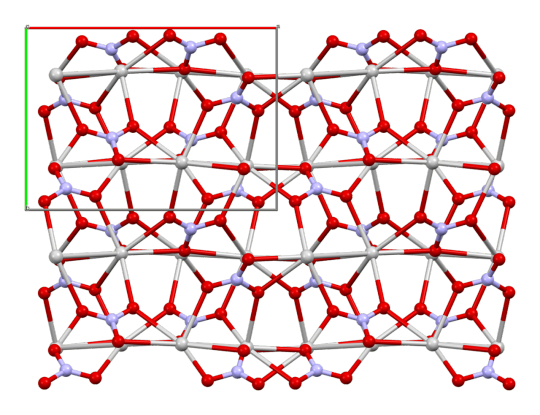
the above is the crystal structure
appearance is just a white crystal kinda like sugar
it took everything in me to not just make silverr plain Ag
silver nitrate is the most common precursor for all other important silver salts
also an extremely important compound in the development of photography! (and iirc silverr is a film major)
Feinberg as Ozone:
O3

produced during lightning strikes
pale blue at high ppm
only leaves gas state at cryogenic temperatures
naturally occurring in the stratosphere and absorbs UV rays from the sun
Fruit as Nickel(II) Chloride Hexahydrate:
NiCl2•6H2O


green
the non-hydrate form is a sort of olive-y yellow color
used to absorb ammonia in gas masks
Raddles as Potassium Permanganate:
KMnO4
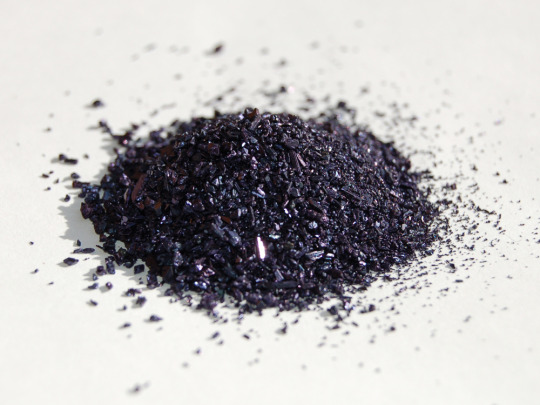

Sometimes referred to as Purple Potion Powder
goes CRAZY purple when dissolved and is lowkey my favorite chemical
very strong oxidizing agent
one time i stained my hand purple through my glove with this shit idk how it happened
if made in specific solvents can look extremely similar to dragon's breath in minecraft imo
K4 as Octathio[8]circulene:
C16S8
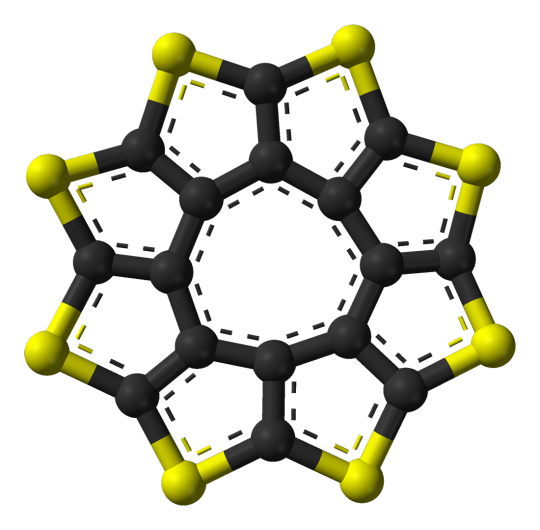
also referred to as Sulflower (like sulfur and sunflower haha get it)
planar which is fairly uncommon for molecules of this size
can be stacked together to make sheets of sulflowers
Cube as Cubane:
C8H8
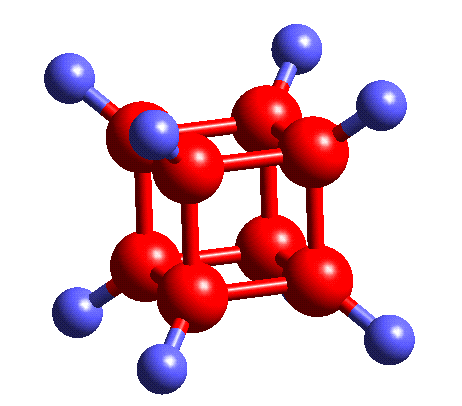
yeah this is self-explanatory
what is interesting though is that ring strain in 4 membered rings/squares is really high, so cubane existing is a bit of a chemical anomaly
i havent read into it enough to know for sure but i suspect that ring strain is why cubane is a precursor to a HELLA STRONG explosive compound
Reignex as PPTA:
Poly-p-paraphenylene terephthalamide
[-CO-C6H4-CO-NH-C6H4-NH-]n

the name is complicated as shit but this is just kevlar!
aka bulletproof vest material
looks fluffy when not woven completely together
aligning of polymer chains w hydrogen bonds creates EXTREMELY high tensile strength
Mime as Phenylmagnesium Bromide:
C6H5MgBr

a common grignard reagent aka a compound that can be used in a grignard reaction, an extremely important reaction in organic synthesis as it creates new C-C bonds
another fun fact about grignard reagents is that if water is added to them- or even if they're handled in particularly moist air- they fucking explode
extremely strong nucleophile and base
Poundcake as Xenon Hexafluoride:
XeF6
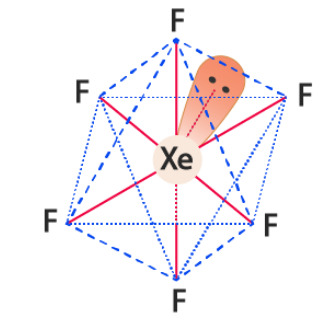
Noble gases don't react unless you REALLY make them
so a compound containing xenon is really interesting
colorless as a solid but sublimes (aka skips straight from solid to gas) into a bright yellow gas
fun fact a lot of instances where typical chemistry rules are broken (noble gases not reacting, octet rule in general, etc) involve fluorine to the point ive heard it referred to as a "batshit electron thief"
Fulham as Iron Hexacyanidoferrate:
C18Fe7N18

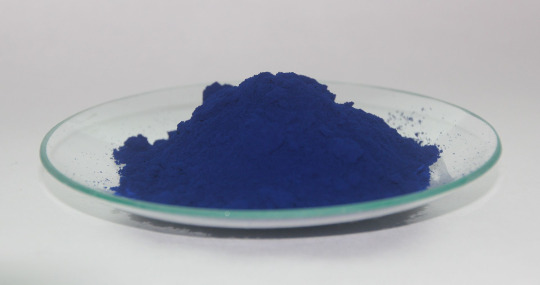
also known as prussian blue
extremely common pigment in paints and the first modern synthetic pigment
used extensively in The Great Wave
another one of my favorite molecules bc im biased and like inorganic chem aka things that contain metals
used as an antidote for heavy metal poisoning which is interesting bc it contains cyanide ligands!
Couriway as Bullvalene:
C10H10
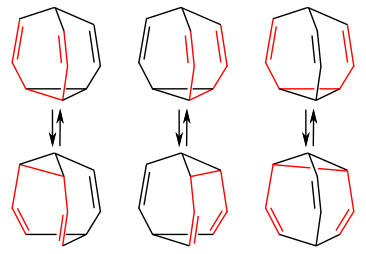
in a state of constant resonance
aka the double bonds are CONSTANTLY shifting and reforming bullvalene into... itself but moved around a little
the bonds fluctuate so rapidly that in nmr analysis each carbon and hydrogen in the entire molecule is read as equivalent (for my non-chem people that's very uncommon and very cool)
formed through photolysis (aka using light/photons to fuel a reaction)
#i made this for me and only me#chemistry is a disease and i will not be getting better anytime soon#90% of these picks are straight soul reads im gonna be so fr#mcsr#hbg#fruitberries#feinberg#couriway#fulham#president poundcake#raddles#silverrruns#reignex#talkingmime#cube1337x#k4yfour
84 notes
·
View notes
Text
"A new community housing development in the Bronx will feature a cool piece of kit: an on-site aerobic digester that can turn 1,100 pounds of food scraps into 220 pounds of high-quality fertilizer every single day.
Built by Harp Renewables, it’s basically a big stomach filled with bacteria that breaks down food scraps and wasted food into their component parts, and in the future could be a standard part of all apartment units as the amount of food waste in American reaches 30% of the total mass of all trash collection.
The Peninsula, organized by Gilbane Development Company, will feature 740 units of affordable housing, 50,000 square-foot light industrial space and equal sized green space, and 15,000 feet of commercial space, all of which will send their castaway comestibles right into the digester...
Fast Company reports that Christina Grace, founder of a zero-waste food management company, helped plan the design and implementation of the digester into The Peninsula, and helped organize a 40% grant from the city to pay the $50,000 upfront cost.
“The goal is for this material to work its way into the community garden network in the Bronx,” [Christina Grace, who helped plan the design] told the magazine, adding that she expects it to pay for itself over just a few years. “We see this as highly replicable in both commercial and residential venues. We know there’s a need for fertilizer.”
Producing fertilizer right there in the city reduces the need for it to be trucked in from afar, chipping away, even if just a bit, at NYC traffic.
Big problem solver
Perhaps uniquely beneficial to New York City compared to other spots in the U.S. is that the digester will have a significant impact on the Bronx’s share of the city’s rodent problem.
Those who’ve watched the Morgan Spurlock documentary Rats will understand why that’s significant—while those that haven’t will have to imagine what living in a megacity where rats outnumber people by around 8 or 10 to 1 looks like.
Another big problem the bio-digesters could potentially help is pollution and greenhouse gas emissions. Fertilizer is a big emitter of all three of the most-targeted GHGs. Fertilizer, like quarry dust and ammonia is, like so many commodities, often imported from countries who specialize in its production, such as Norway, but also Russia and Ukraine, whose conflict has recently highlighted the fragility of the supply chain with sharp increases in prices...
Bio-digesters by design keep the CO2 and methane in the fertilizer produced, rather than it entering the atmosphere.
For these reasons and more, the aerobic bio-digester is slowly making its way into residential and industrial spaces around the country.
GNN reported on an enormous bio-digester at the heart of the D.C. advanced resource (sewage) recovery center outside the capital, and on the use of bio-digesters on Australian pig farms which are helping reduce the environmental and psychological impact of the effluent produced from such operations.
Harp Renewables tweeted how happy they were to have installed their bio-digester in the town of Cashel, Ireland.
Expect to see more stories like this pop up around the globe."
-via Good News Network, March 17, 2022
Note: Obviously gentrification bad and "affordable housing" is sometimes nowhere near as affordable as it should be, etc. etc. That said, this is such a fantastic use case that I felt I had to post it anyway.
#new york#new york city#bronx#bronx new york#supply chain#fertilizer#circular economy#sustainability#sustainable architecture#sustainable agriculture#united states#apartment buildings#bio-digester#good news#food waste#organic waste#hope#hope posting
325 notes
·
View notes
Text
Time, yet again, to wade into a pit of contradictory information as I try to determine what I should do about my nuked tetra population while I'm still doing ich treatment.
(if you have some ideas/opinions about what I should do context below)
This is my first tank, so please be nice 🥺
I have a heavily planted, 20gallon (76L) freshwater aquarium which I had probably researched for about 3 months, then ran empty/with plants for about a month or so? before fish introduction. So absolutely cycled, bombproof setup that I have not seen a whiff of ammonia or nitrates in since I started testing (probably a month after it being cycling empty when my kit arrived).
I introduced 10 green neon tetra, which grew confident very quick within the new tank, like within the next day stopped schooling behaviour, bopping around and doing their own thing. But then I saw white spots appearing. In my delay of trying to determine if it was actually ich and conflicting info about it being 'stress ich' that could minimize in time with the stress reduction - probably me delaying it too because the meds were expensive - I probably doomed them.
I'm angry and sad at the same time, in part towards myself but mostly because I'm mad at the contradictory info leading to delay on a situation that was more time critical given the size of these little fish. Which I think led to their deaths.
I know quarantine is important but given my tank is heavily planted, I was struggling with bioload - as in not enough - so on the day I started ich treatment I put in 6 corycats which have been absolutely fine. So fine in fact I've noticed their barbels getting much longer! They're having a great time in there, and while I've seen some showing sign of being itchy, I've never seen a spot appear. Same with the Starlight Bristlenose, who was actually the first resident - she's weathered the ich outbreak pre-treatment fine (yeah I know it's hard to tell given she's a starlight but I've had a good look at her when I could, she's clear) and while she hides a lot during the day, I think she's happy - there are a stupid amount of tunnels and hidey holes in my setup, the centerpiece is a huge slab of driftwood so she has plenty to rasp on too. All the food is also the best quality I could get, and they get blanched veggies twice a week.
Unfortunately though, the delay was too late for the Tetra. First I lost one. Then more. I went from 10 to 3 today, if I am lucky it will stay at 3. Two of them look very good. One of them has minor body spotting. Worst comes to worst, it'll be 2. I think it'll stay that way, nothing new has been appearing.
What I am worried about now is I know the minimum for tetra is 8. While these guys I think know fairly well the tank is safe, and the presence of the corycats might help in terms of them having another grouping fish around to help them feel more confident, I don't want to be causing them unnecessary stress that might make the situation worse. Two of them left are grouping together, the one I am uncertain about is often hanging out on it's own which is making me worried I'll lose it too.
I am early on in the treatment at full dosage (I spent more time cranking up the dosage slowly since this is a planted tank with inverts, so that probably didn't help the ich situation) 25%~30% water changes daily.
Naturally online opinion on 'should I add fish during ich treatment' is about as confusing as it was when I was just trying to find info on ich. Some say hard no. Some say it's always in tanks anyway, it's the stress, may as well chuck them in during treatment. I'm going to have to grab another bottle of the stuff (so bleeding expensive) and I don't want to use more of it on a quarantine tank - right now anyway.
The treatment I am doing specifically targets parasites (Seachem Paraguard) but I also have Melafix and Pimafix, though I haven't really been dosing either since the smell of it I think irritates the tetra, and Paraguard supposedly has antibacterial elements that also target finrot. If I were to add new fish, I'd probably start adding both during the day, Paraguard goes in at night after a waterchange because it's lights-off after that (degrades under light).
If I added new fish, I'd be doing that for 14 days + maybe one more week just in case. But yeah, I have no fucking clue what to do and I very much want to not fuck this up anymore.
I'm also honestly kind of put off by tetra at this point - compared to the corycats they are very, very nervous and twitchy I think which didn't help their stress levels, even with me trying to make it as stress-free as possible. But also know I'm probably stuck with them if I want them to feel better.
Any thoughts/opinions would be good. I don't really have other treatment options available either btw, either because products are literally not available or the risk of killing plants/hurting other fish is too high (heat is NOT an option, corycats upper-limit is 26C so that's what the tank is set to)
My gut says it's probably okay to add fish, if I keep up treatment. But idk anymore :C
#kerytalk#aquablr#tagging it this out of the hope someone could help but also be nice this is my first tank#fishblr
13 notes
·
View notes
Text
Hi folks! I come today with a long, emotional and painful scene. ❤️
There was no emotion on Tommy's face. He didn't even have to bother pretending to be impassive. It was not isolation and not detachment. It was what it looked like: he had torn off the feelings as if they had never existed. As if he were not a human being. As if he knew himself not to be, that he could never be fully that again, and now he was showing it to her. He wanted her to see him through his transformation, Grace realised in disbelief. To make her disgust by it.
"The Germans. Soldiers just like me. The same toys on the blackboard, the size of which can never be comprehended by reason. Among them was the boy with the green eyes. They found their way out of the tunnels, through the mud, through the filth, took me back into the darkness, no matter how I fought with them. I looked down at my hand. It was covered in blood." His eyelids fluttered as if he wanted to look down at his hands resting palms up. Finally his gaze stayed where it was. By then the nihil of destruction had reached him. Everything was happening in his eyes. "I thought: whose hand is this? It cannot be mine. I can’t exist in a reality, where these hands belong to me just as any other parts of my body. A terrible, burning wave of pain washed over me from my shoulder. I was shot. I thought: finally. Finally I can lie down on the ground and die. All it need was a little bit more. But that little suddenly become too much." Hollowed-out, frozen dread, and burning fright like the fire that heats the blast furnaces of factories. "I opened my eyes, I was there again. Just me, Danny and Freddie. We fight for our lives like rats for the last piece of raw meat. I was writhing on the ground, in my nose a mixture of ammonia, gunpowder and some sludgy, sticky, disgusting mass, crawling to the ladder. Danny screamed, Freddie… I had no idea what had happened to him. I couldn’t make out anything in the darkness, not the shapes of people or the walls of the tunnels, I could only hear the voices and smell the smells. It was as if I had become blind. I begged with the last shreds of my faith for someone to gouge out my eyes, to save me from the ability to see this… I kept crawling and crawling, after a while I began to think that my legs were torn off, that I had no body anymore, but even then I didn’t give up. I clung to the pain, digging my nails into it through the darkness to stay conscious. Ever since Greta’s death, I’ve had this tainted, bile-tasting smell of sickness and death with me. "He shuddered, his face contorted in disgust. "I wanted to vomit. I think I did. I opened my mouth and then some hideous, unnamable taste filled my throat. I couldn’t breath he gasped. My shoulder was on fire. I wanted to die. All my prayers were for a German soldier to plunge his bayonet into me and bring me death. I wanted to give up, yet I dragging myself forward, because somewhere nearby was a ladder. If I could take my hand on it, I could climb to the surface and get out. In the end I never reached it" he breath out the last words.
Before Grace was aware of what she was doing, she was already observing that she had started a determined protest.
"Yes, you did! You left the tunnel behind. It feel’s like you still there, like you’re being swallowed up by the darkness, but you’re already here with me, in this actual, concrete reality." Both her hands were on Tommy's cheekbone, causing Tommy to blink rapidly. "Can you feel that? Because I feel you." Resisting the demand in her blood to put Tommy's face on a level with her own, to give him no choice but to look into her eyes. The words rolled from Grace's lips with a wild freedom. "You are warm and alive. The pain is gone. The bullet wound is here without looking," she traced with her fingers the bruised skin behind his shoulder, its jagged unevenness reminding them both of its origins. Tommy sucked in air, his chest rising. Grace's palm found its way back to his face. "This is real, Tommy. The tunnels, the suffering, the heat, the taste in your mouth, the green-eyes soldier boy can’t touch you. Those things can’t hurt you anymore, because I’m here. You and me, this place is real, safe and constant. We made it that way. You can touch it, you can feel it," she said urgently. "Everything else is in the past. Memories and fears."
Tommy squeezed his eyes shut, shook his head. "They'll come for me again. I know they will," he repeated, his voice hushed. The shaking of his head stopped, his eyelashes fluttered open. "Whenever I close my eyes, they are already there."
"And I am here!" Tommy stared at her in bewilderment, and as she glanced into the irises surrounding the dilated pupils, Grace took the opportunity. She locked their eyes commandingly, blocking the chance of looking away from her, he couldn't even try. Her hold tightened on Tommy's cheek. She leaned toward him with a blazing glare. "In front of you, in your arms. If they want you, they'll have to ended me first! I will not give you without a fight!"
Tommy stared at her in a dazed stupor. "Would you fight them for me?"
Any other time the question would have left his lips with a hint of mocking, making it clear that the irony was as much his own as Grace's. But now it sounded as if it freed in him genuine hope, yearning, trust and fear. He didn't believe anyone would fight for him, Grace understood that early on. He knew that there was no one in the world who would dare to go with him to the field littered with the dead. Until now.
I'd fight the whole world for you, Grace thought. She managed a smile.
"No one's scarier than me when I'm in a rage."
The sound Tommy made was the equivalent of a snort and a sniffle. "My personal experience compels me to confirm this." A brilliant light flickered in his eye. His gaze warmed, but Grace kept her belligerent expression. She replied in an undertone of intimidation.
"Anyone irresponsible enough to hurt someone I'm trying to look after will learn very quickly, at the cost of a hard lesson, why that would be a terrible idea."
A shadow of a smile appeared on Tommy's lips to match his sparkling eyes. Grace relaxed against her will. The convulsive force of gripping Tommy's face in the palm of her hand was no longer tense in the joints between her fingers. Released from the grip of tension, she was still a little afraid that her gratification was premature. Caressing the skin of Tommy's cheekbone, her hesitation disguised as self-control.
"Do I enjoy your protection?" Tommy questioned. Curiosity accompanied the enquiry.
"I am your captain." The sentence followed the announcement included a raised eyebrow. "Do you dare question your superior officer, Sergeant Major?"
Without real devotion, Tommy smiled faintly. He stopped his rising hand in the air between their faces. He eyed Grace with reservations, concerns. Whatever he saw in her, and Grace really couldn't tell what it might be, she supplemented with a nod of agreement.
Tommy ran the back of his hand over her chin. On her cheek, he continued the endearing strokes inspired by kindness, affection and gratitude.
"I wouldn't do that. It is forbidden by military protocol. However, allow me to make an observation. Since you hold the rank of captain, shouldn't it be the other way around? The differences between our ranks dictate that my duty and purpose in life is your service and protection."
Grace had a more flexible view than that.
"No one in my jurisdiction can lay a hand on my people. Unconventional leadership is combined by peculiar principles." She lowered her voice and, tilting her head to one side, motioned toward the other side of the room. "Come back to bad!"
Tommy paused between stroking motions. "You say that like a commander to a member of her team?" There was something about the way he handled the words. It was as if he was testing the limits of this new formation, with which he had made friends at first sight.
Grace projected a seriousness worthy of it.
"I ask you as a woman who wishes to embrace her lover." Then, after a moment's thought, with half-lidded eyes, she approached Tommy. Her hand trailed down the side of his neck, evaded his mouth, touched her lips to his ear. "I miss your warmth," she murmured softly, invitingly.
Tommy's eyes closed. His resigned sigh had an amused theatricality that made them chuckle quietly.
#peaky blinder fanfic#grace burgess#writing#grace x tommy#fanfiction#tommy shelby#tommy and grace#peaky blinders#grace x tommy fanfic#thomas shelby#emotional scene#great war#tunneler
16 notes
·
View notes
Text
The Midnight Masquerade Part 1
Dead Men Tell No Tales,
The smell of ammonia filled the air. Vibrant green eyes blinked open as Cassandra woke up. Her wavy platinum hair moved slightly from her shoulders as she sat up, stretching her arms. She blinked, looking around her room trying to adjust to the sunlight in the dark colored room, but everything was blurry. She never could see well ever since she was little from what she can recall. Cassandra reached over to her nightstand, picking up her glasses and putting them on. There were various dolls and stuffed animals, such as teddy bears but most were rabbits, sitting on the shelves. A few stuffed rabbits were made by the Funtom Corp, had an eye patch and were dressed in suits and top hats while some had different colored dresses.
Cassandra got up and started to make up the bed and put on her work clothes to get ready for today. She pulled out a long black dress from the closest that reached her knees and dark stockings and shoes. Her friend must be up already. Cassandra stepped out of her room. There were many jars on the shelves filled with organs and body parts and chemicals. Sitting on the corners of the room were some candles and skulls and cobwebs on the ceiling. Lined up on the walls were many coffins ranging from large to child size. In front of her was a person lying on the table, dead. As Cassandra walked over to look, she saw that it was a woman probably almost around her age. Her body was covered head to toe in stitching as she was sewed up. Her skin was pale and cold to touch. But where was her friend?
"Hey, where are you?" Cassandra called out to them but received no response. Cassandra looked around the room, wondering where her friend was until she saw a coffin that was slightly opened. She quietly walked over to it and placed her hand on the lid. The lid flipped open with a loud bang. Cassandra stood still, smiling a little, as she saw the face almost close to hers, giggling. A man with long grey hair and long bangs, covering his eyes. There were also scars on parts of his body. One on his finger, another around his neck and half a scar on the right side of his cheek, heading up to his covered face. He was wearing a mortician outfit, heeled boots, and a dark top hat that had a long ribbon hanging off of it. The Undertaker.
"About time you woke up? Did I scare you?" The Undertaker laughed, giggling some more.
"That trick might have worked when I was younger, but, no, you didn't. Nice try, though." Cassandra smiled.
"You're no fun, Cassie. I love to hear that lovely scream of yours." The Undertaker whining a little. Cassandra ignored him and walked over to the table.
"So, who's the latest victim?" Cassandra pointed out. Undertaker walked over, standing beside her.
"Such a pretty thing. Unfortunately, she came to an untimely end. She was found in the streets, completely hacked up to pieces. But I managed to put her back to together again!" The Undertaker smiled.
"Hacked to pieces? Don't tell me Jack the Ripper did this...This is happening a lot lately. The poor thing." Cassandra frowned, looking down at the woman, sadly.
"That is why I must ask you. I want you to be careful on your walks." The Undertaker told her.
"I'll be fine-" Cassandra spoke before she gasped when a hand was placed on her cheek. Her eyes blinked wide, blushing a little, as she felt the cold hand of the Undertaker's. His expression had a stern look but still had a small smile.
"I know. But promise me that you will be careful." He told her. "I can't always be around to protect you. I promised your father before his death that I would look after you. You are precious to me, and I can't lose you. I won't have anyone take you away from me."
"I-I promise." Cassandra swallowed. The Undertaker pulled back his hand and grinned widely.
"Now off with you. Go and have your fun and I'll finishing preparing for this woman's funeral." He told her. Cassandra blinked and walked away and looked back at the Undertaker one last time and left the shop.
After a while of walking in the streets, Cassandra noticed the sun was starting to go down. Maybe it was time to head back. From the news, Jack the Ripper only strikes at night. The streets were dangerous during that time. As she turned around the corner to head back to the Undertakers, Cassandra bumped into someone. It was a young man.
"Oof!" Cassandra stumped back, almost losing her balance. The man fell back landing on his butt, dropping some boxes, that sounded like had some fragile items in them as they crashed to the ground. His round rimmed glasses fell off from his face landing on the ground. He quickly scrambled around on the ground trying to find them.
"I'm terribly sorry! I didn't see you!" He sputtered, frantically, still looking for his glasses, while trying to pick up the boxes as well. Cassandra got a better look at him. He was kind of handsome she had to admit. He had green eyes, long brown hair tied up with a red ribbon, in a ponytail. He was also wearing a butler's uniform underneath a dark coat, a red and white striped ribbon tied around his neck, and white gloves.
"What are you apologizing for? I was the one who wasn't looking where I was going and bumped into you." Cassandra bent down and picked up the glasses that were lying near her feet and walked over to him. "Here." She handed him his glasses and he took them from her, putting them back on.
"Thank you." The man blinked and paused, looking at Cassandra, staring at her. He was completely awestruck by her beauty. Who was she? Cassandra quickly moved away from him and began to help pick up the boxes from the ground.
"So where are you headed?" She asked him.
"The Phantomhive Manor. I was picking up a delivery for my mistress and meet her there." He told her and picked up some of the boxes.
"I can help you take them there, if you want. There are a lot to carry and some of them sound broken. I can explain to them that it was my fault, so you won't get in trouble. I sort of know the Phantomhives, considering they are our regular clients."
"Your clients? What sort of business do you do?" He asked her.
"Well, I don't run it. My friend does. He works in a morgue, you know, dead bodies and such." She told him. "If you don't mind me asking, what's your name?"
"My name is Grell Sutcliffe." He told her, nervously, before he quickly bowed a little. "What is yours?"
"I'm Cassandra. Cassandra Gravesfield." She told him.
"That's a pretty name." He told her.
"Thanks." She smiled.
The two walked carrying the box as they headed over to the Phantomhives mansion.
#fanfiction#read more#black butler#kuroshitsuji#undertaker#black butler undertaker#grell#kuroshitsuji grell#sebastian black butler
3 notes
·
View notes
Text
Green Ammonia Market Size and Share Analysis: Key Growth Trends and Projections

Green Ammonia Market Strategies: Taking Advantage of Trends to Drive Growth in 2032
The Green Ammonia Market Report provides essential insights for business strategists, offering a comprehensive overview of industry trends and growth projections. It includes detailed historical and future data on costs, revenues, supply, and demand, where applicable. The report features an in-depth analysis of the value chain and distributor networks.
Employing various analytical techniques such as SWOT analysis, Porter’s Five Forces analysis, and feasibility studies, the report offers a thorough understanding of competitive dynamics, the risk of substitutes and new entrants, and identifies strengths, challenges, and business opportunities. This detailed assessment covers current patterns, driving factors, limitations, emerging developments, and high-growth areas, aiding stakeholders in making informed strategic decisions based on both current and future market trends. Additionally, the report includes an examination of the Automatic Rising Arm Barriers sector and its key opportunities.
According to Straits Research, the global Green Ammonia Market market size was valued at USD 0.35 Billion in 2022. It is projected to reach from USD XX Million in 2023 to USD 62.1 Billion by 2031, growing at a CAGR of 77.78% during the forecast period (2023–2031).
Get Free Request Sample Report @ https://straitsresearch.com/report/green-ammonia-market/request-sample
TOP Key Industry Players of the Green Ammonia Market
CF Industries Holdings Inc.
CSBP Limited
EuroChem
Group DF
IFFCO
Koch Fertilizer, LLC
OCI Global
PJSC Togliattiazot
Qatar Fertiliser Company
Yara International
Global Green Ammonia Market: Segmentation
As a result of the Green Ammonia market segmentation, the market is divided into sub-segments based on product type, application, as well as regional and country-level forecasts.
By Electrolysis Type
Liquid
Gas
By End Use
Agriculture
Textile
Mining
Pharmaceutical
Refrigeration
Others
By Sales Channel
Direct
Distribution
Browse Full Report and TOC @ https://straitsresearch.com/report/green-ammonia-market/request-sample
Reasons for Buying This Report:
Provides an analysis of the evolving competitive landscape of the Automatic Rising Arm Barriers market.
Offers analytical insights and strategic planning guidance to support informed business decisions.
Highlights key market dynamics, including drivers, restraints, emerging trends, developments, and opportunities.
Includes market estimates by region and profiles of various industry stakeholders.
Aids in understanding critical market segments.
Delivers extensive data on trends that could impact market growth.
Research Methodology:
Utilizes a robust methodology involving data triangulation with top-down and bottom-up approaches.
Validates market estimates through primary research with key stakeholders.
Estimates market size and forecasts for different segments at global, regional, and country levels using reliable published sources and stakeholder interviews.
About Straits Research
Straits Research is dedicated to providing businesses with the highest quality market research services. With a team of experienced researchers and analysts, we strive to deliver insightful and actionable data that helps our clients make informed decisions about their industry and market. Our customized approach allows us to tailor our research to each client's specific needs and goals, ensuring that they receive the most relevant and valuable insights.
Contact Us
Email: [email protected]
Address: 825 3rd Avenue, New York, NY, USA, 10022
Tel: UK: +44 203 695 0070, USA: +1 646 905 0080
#Green Ammonia Market#Green Ammonia Market Share#Green Ammonia Market Size#Green Ammonia Market Research#Green Ammonia Industry#What is Green Ammonia?
0 notes
Text
Study finds health risks in switching ships from diesel to ammonia fuel
New Post has been published on https://thedigitalinsider.com/study-finds-health-risks-in-switching-ships-from-diesel-to-ammonia-fuel/
Study finds health risks in switching ships from diesel to ammonia fuel


As container ships the size of city blocks cross the oceans to deliver cargo, their huge diesel engines emit large quantities of air pollutants that drive climate change and have human health impacts. It has been estimated that maritime shipping accounts for almost 3 percent of global carbon dioxide emissions and the industry’s negative impacts on air quality cause about 100,000 premature deaths each year.
Decarbonizing shipping to reduce these detrimental effects is a goal of the International Maritime Organization, a U.N. agency that regulates maritime transport. One potential solution is switching the global fleet from fossil fuels to sustainable fuels such as ammonia, which could be nearly carbon-free when considering its production and use.
But in a new study, an interdisciplinary team of researchers from MIT and elsewhere caution that burning ammonia for maritime fuel could worsen air quality further and lead to devastating public health impacts, unless it is adopted alongside strengthened emissions regulations.
Ammonia combustion generates nitrous oxide (N2O), a greenhouse gas that is about 300 times more potent than carbon dioxide. It also emits nitrogen in the form of nitrogen oxides (NO and NO2, referred to as NOx), and unburnt ammonia may slip out, which eventually forms fine particulate matter in the atmosphere. These tiny particles can be inhaled deep into the lungs, causing health problems like heart attacks, strokes, and asthma.
The new study indicates that, under current legislation, switching the global fleet to ammonia fuel could cause up to about 600,000 additional premature deaths each year. However, with stronger regulations and cleaner engine technology, the switch could lead to about 66,000 fewer premature deaths than currently caused by maritime shipping emissions, with far less impact on global warming.
“Not all climate solutions are created equal. There is almost always some price to pay. We have to take a more holistic approach and consider all the costs and benefits of different climate solutions, rather than just their potential to decarbonize,” says Anthony Wong, a postdoc in the MIT Center for Global Change Science and lead author of the study.
His co-authors include Noelle Selin, an MIT professor in the Institute for Data, Systems, and Society and the Department of Earth, Atmospheric and Planetary Sciences (EAPS); Sebastian Eastham, a former principal research scientist who is now a senior lecturer at Imperial College London; Christine Mounaïm-Rouselle, a professor at the University of Orléans in France; Yiqi Zhang, a researcher at the Hong Kong University of Science and Technology; and Florian Allroggen, a research scientist in the MIT Department of Aeronautics and Astronautics. The research appears this week in Environmental Research Letters.
Greener, cleaner ammonia
Traditionally, ammonia is made by stripping hydrogen from natural gas and then combining it with nitrogen at extremely high temperatures. This process is often associated with a large carbon footprint. The maritime shipping industry is betting on the development of “green ammonia,” which is produced by using renewable energy to make hydrogen via electrolysis and to generate heat.
“In theory, if you are burning green ammonia in a ship engine, the carbon emissions are almost zero,” Wong says.
But even the greenest ammonia generates nitrous oxide (N2O), nitrogen oxides (NOx) when combusted, and some of the ammonia may slip out, unburnt. This nitrous oxide would escape into the atmosphere, where the greenhouse gas would remain for more than 100 years. At the same time, the nitrogen emitted as NOx and ammonia would fall to Earth, damaging fragile ecosystems. As these emissions are digested by bacteria, additional N2O is produced.
NOx and ammonia also mix with gases in the air to form fine particulate matter. A primary contributor to air pollution, fine particulate matter kills an estimated 4 million people each year.
“Saying that ammonia is a ‘clean’ fuel is a bit of an overstretch. Just because it is carbon-free doesn’t necessarily mean it is clean and good for public health,” Wong says.
A multifaceted model
The researchers wanted to paint the whole picture, capturing the environmental and public health impacts of switching the global fleet to ammonia fuel. To do so, they designed scenarios to measure how pollutant impacts change under certain technology and policy assumptions.
From a technological point of view, they considered two ship engines. The first burns pure ammonia, which generates higher levels of unburnt ammonia but emits fewer nitrogen oxides. The second engine technology involves mixing ammonia with hydrogen to improve combustion and optimize the performance of a catalytic converter, which controls both nitrogen oxides and unburnt ammonia pollution.
They also considered three policy scenarios: current regulations, which only limit NOx emissions in some parts of the world; a scenario that adds ammonia emission limits over North America and Western Europe; and a scenario that adds global limits on ammonia and NOx emissions.
The researchers used a ship track model to calculate how pollutant emissions change under each scenario and then fed the results into an air quality model. The air quality model calculates the impact of ship emissions on particulate matter and ozone pollution. Finally, they estimated the effects on global public health.
One of the biggest challenges came from a lack of real-world data, since no ammonia-powered ships are yet sailing the seas. Instead, the researchers relied on experimental ammonia combustion data from collaborators to build their model.
“We had to come up with some clever ways to make that data useful and informative to both the technology and regulatory situations,” he says.
A range of outcomes
In the end, they found that with no new regulations and ship engines that burn pure ammonia, switching the entire fleet would cause 681,000 additional premature deaths each year.
“While a scenario with no new regulations is not very realistic, it serves as a good warning of how dangerous ammonia emissions could be. And unlike NOx, ammonia emissions from shipping are currently unregulated,” Wong says.
However, even without new regulations, using cleaner engine technology would cut the number of premature deaths down to about 80,000, which is about 20,000 fewer than are currently attributed to maritime shipping emissions. With stronger global regulations and cleaner engine technology, the number of people killed by air pollution from shipping could be reduced by about 66,000.
“The results of this study show the importance of developing policies alongside new technologies,” Selin says. “There is a potential for ammonia in shipping to be beneficial for both climate and air quality, but that requires that regulations be designed to address the entire range of potential impacts, including both climate and air quality.”
Ammonia’s air quality impacts would not be felt uniformly across the globe, and addressing them fully would require coordinated strategies across very different contexts. Most premature deaths would occur in East Asia, since air quality regulations are less stringent in this region. Higher levels of existing air pollution cause the formation of more particulate matter from ammonia emissions. In addition, shipping volume over East Asia is far greater than elsewhere on Earth, compounding these negative effects.
In the future, the researchers want to continue refining their analysis. They hope to use these findings as a starting point to urge the marine industry to share engine data they can use to better evaluate air quality and climate impacts. They also hope to inform policymakers about the importance and urgency of updating shipping emission regulations.
This research was funded by the MIT Climate and Sustainability Consortium.
#000#Accounts#Aeronautical and astronautical engineering#aeronautics#air#air pollution#air quality#America#ammonia#Analysis#approach#Asia#asthma#atmosphere#author#Bacteria#betting#burns#carbon#Carbon dioxide#carbon dioxide emissions#carbon emissions#carbon footprint#Center for Global Change Science#change#Cleaner industry#climate#climate change#college#container
2 notes
·
View notes
Text
“A Potentially Habitable World Over 8 Times Bigger than Earth”

Webb telescope has detected carbon dioxide and methane in the atmosphere of exoplanet K2-18 b, a potentially habitable world over 8 times bigger than Earth. Webb’s data suggests the planet might be covered in ocean, with a hydrogen-rich atmosphere

The abundance of methane and carbon dioxide, and shortage of ammonia, support the hypothesis that there may be a water ocean underneath a hydrogen-rich atmosphere in K2-18 b.
These initial Webb observations also provided a possible detection of a molecule called dimethyl sulfide (DMS). On Earth, this is only produced by life. The bulk of the DMS in Earth’s atmosphere is emitted from phytoplankton in marine environments.
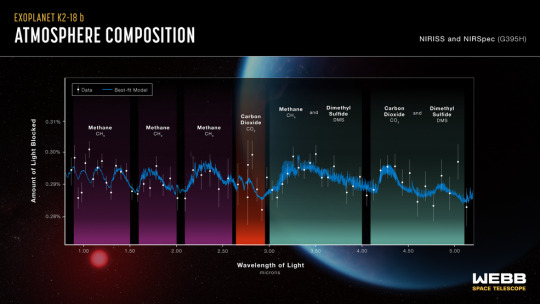
The graphic shows Webb's spectra of the exoplanet K2-18 b. Magenta, red and green vertical columns across the plot indicate signatures of methane, carbon dioxide, and dimethyl sulfide. Behind the graph is an illustration of the planet and its star.
5 notes
·
View notes
Text
Hydrogen Energy Storage Market Size, Share & Growth | Forecast 2025-2032

The hydrogen energy storage market is emerging as a critical component in the global transition to renewable energy, driven by increasing demand for clean energy solutions, technological advancements, and supportive government policies. According to SkyQuest Technology, the Hydrogen Energy Storage Market size is poised to reach to USD 22.60 Billion by 2032, growing at a CAGR of 4.4% during the forecast period. This market offers innovative solutions to meet energy storage demands while addressing environmental concerns.
Market Size and Growth Projections
The hydrogen energy storage market is witnessing significant growth as industries and governments focus on decarbonization and clean energy. Hydrogen's ability to store energy over long periods and its role in balancing supply and demand are pivotal in accelerating its adoption.
Request a Sample of the Report here: https://www.skyquestt.com/sample-request/hydrogen-energy-storage-market
Key Market Drivers
Global Push for Clean Energy Increasing pressure to reduce carbon emissions is driving investments in hydrogen energy storage technologies.
Energy Resilience and Grid Stabilization Hydrogen storage solutions provide critical support for grid balancing, enabling consistent energy supply.
Government Policies and Incentives Policies aimed at promoting green hydrogen production and usage are accelerating market growth.
Integration with Renewable Energy Sources Hydrogen enables efficient storage of surplus energy generated by solar and wind systems, enhancing their viability.
Market Segments
The hydrogen energy storage market is segmented based on storage type, end-user, and application:
By Storage Type:
Liquid Hydrogen
Gas Hydrogen
Solid Hydrogen
By End-User:
Industrial
Commercial
Residential
By Application:
Transportation
Stationary Power
Portable Power
Speak with an Analyst for More Insights: https://www.skyquestt.com/speak-with-analyst/hydrogen-energy-storage-market
Regional Insights
North America: The region dominates the market, driven by government initiatives and investments in green hydrogen technologies.
Europe: Europe's commitment to achieving net-zero emissions is fostering the adoption of hydrogen energy storage solutions across various sectors.
Asia-Pacific: The region is experiencing rapid growth due to rising industrialization, urbanization, and investments in renewable energy.
Latin America & Middle East: These regions are leveraging hydrogen to address energy security challenges and support sustainable development.
Buy the Report to Get the Full Analysis: https://www.skyquestt.com/buy-now/hydrogen-energy-storage-market
Top Players in the Market
Key players in the hydrogen energy storage market are investing in research and development to offer advanced and cost-effective solutions. Prominent companies include:
Air Liquide
Linde PLC
Cummins Inc.
Nel ASA
Plug Power Inc.
Ballard Power Systems
ITM Power PLC
Hydrogenics Corporation
McPhy Energy S.A.
Chart Industries, Inc.
View Full ToC and List of Companies here: https://www.skyquestt.com/report/hydrogen-energy-storage-market
Emerging Trends
Advancements in Electrolyzer Technology Innovations in electrolyzers are reducing costs and enhancing hydrogen production efficiency.
Green Hydrogen Adoption The growing preference for hydrogen produced from renewable sources is transforming the market landscape.
Expansion of Hydrogen Refueling Infrastructure Development of hydrogen refueling stations is supporting the adoption of fuel cell electric vehicles (FCEVs).
Industrial Applications of Hydrogen Hydrogen is increasingly being used in industries such as steel production, chemical manufacturing, and ammonia synthesis.
The hydrogen energy storage market holds immense potential as the world shifts toward sustainable and clean energy solutions. By focusing on technology, scalability, and integration with renewable energy systems, companies can leverage significant growth opportunities in this dynamic market.
#Hydrogen Energy Storage Market#Hydrogen Energy Storage Market Size#Hydrogen Energy Storage Market Share#Hydrogen Energy Storage Market Trends#Hydrogen Energy Storage Market Growth#Hydrogen Energy Storage Market Outlook#Hydrogen Energy Storage Market Key Players#Hydrogen Energy Storage Market Overview#Hydrogen Energy Storage Market Competitor#Hydrogen Energy Storage Market Insights#Hydrogen Energy Storage Market Forecast#Hydrogen Energy Storage Market Analysis#Hydrogen Energy Storage Market Statistics#Hydrogen Energy Storage Market Data#Hydrogen Energy Storage Market PDF#Hydrogen Energy Storage Market Excel#Hydrogen Energy Storage Market Strategy#Hydrogen Energy Storage Market Innovations
0 notes
Text
Best Indoor Plants for Office Environment | Chaperone
In today’s fast-paced world, a pleasant workspace has become more crucial than ever. Not only do office environments dictate productivity, but they also have a significant impact on our mental well-being. One of the most effective ways to enhance your workspace is by incorporating greenery. This not only beautify a room but also purify the air and boost mood. So, what are the best indoor plants for an office environment? Let’s dig deeper and explore the top contenders.
1. Snake Plant (Sansevieria)
It is also known as Mother-in-Law's Tongue, is a tough one that thrives in various conditions. Even if you're not exactly a green whisperer, the Snake Plant will more than likely survive your occasional forgetfulness when it comes to watering. This hardy one can tolerate low light levels, is drought-resistant, and purifies the air by filtering out toxic substances. Place it in a stylish pot on your desk or near a window; it will make a statement without demanding too much attention.
2. ZZ Plant (Zamioculcas zamiifolia)
If you're looking for something that requires little care but looks chic, the ZZ should be on your list. Known for its glossy, dark green leaves, this one is mainly for office environments and is perfect for both bright and low-light spaces. ZZs thrive on neglect, so you can focus on your work instead of worrying about a watering schedule. Moreover, they improve indoor air quality, making them a healthy addition to the office.
3. Peace Lily (Spathiphyllum)
The Peace Lily is another excellent choice for office spaces, famous for its elegant white blooms and its ability to thrive in low-light conditions. This indoor flowering greens is not only aesthetically pleasing but also a top performer when it comes to air purification. Peace Lilies absorb harmful toxins such as ammonia and formaldehyde, ensuring a healthier workspace. Just keep the soil moist (but not soggy) and watch this beauty flourish.
4. Pothos (Epipremnum aureum)
If you're in search of a low-maintenance ones with cascading vines, Pothos is the perfect fit. This resilient one is perfect for hanging arrangements or as a decorative element on a shelf. It grows rapidly and doesn’t require much light to thrive, making it ideal for office environments. The Pothos is complex enough to keep your space interesting, yet forgiving enough for the novice green parent.
5. Spider Plant (Chlorophytum comosum)
This is another fantastic option known for its long, arching leaves and "baby" plantlets that dangle down. This charming little one is not only easy to care for but also works wonders in purifying the air. It thrives in indirect sunlight and can tolerate various light conditions. Just keep in mind that a gardening tools set might come in handy for repotting and maintaining its growth as they matures.
6. Dracaena
Dracaena comes in various species, each with unique leaf patterns and heights. Lilian and Marginata are popular choices for offices due to their striking appearance and ability to thrive in direct or indirect sunlight. They are also known to filter out toxins, making them a wonderful addition to any workspace. Just be sure to keep them from drafts and ensure no direct exposure to hot, dry air.
7. Rubber Plant (Ficus elastica)
This has become a favorite among those who want a larger indoor plant for their office. Its broad, glossy leaves add an air of sophistication to any workspace. This one prefers bright, indirect sunlight and moderately moist soil. It also requires infrequent care, making it an ideal fit for busy professionals. Besides being a stylish addition to any office, this also help improve air quality.
Tips for Choosing Indoor Plants for Your Office
When selecting the right indoor plants for your workspace, consider the following tips:
Light Conditions: Evaluate the lighting in your office. If natural light is limited, opt for low-light ones like the ZZs, Snake Plant, and Dracaena.
Size: Ensure that theone you choose fit well within your office space. Large ones like Dracaena and Rubber Plants may require more room, while smaller options like Pothos and Spider Plants can fit into tighter spots.
Maintenance Needs: If you're often busy, low-maintenance varieties will be most suitable.
Aesthetics: Find ones that resonate with your style and work well with your office decor. Beautiful pots can also enhance the visual appeal.
Where to Buy Indoor Plants for Your Office
If you're wondering where to find these wonderful indoor plants for your office, look no further than the best plant nursery in Delhi or the best place to buy indoor plants online. Many local nurseries offer a broad selection of indoor houseplants. In this situation, Chaperone is the best choice, you can find useful gardening tools and pots to complement your new green friends. If you’re not comfortable with plant care, you could also consider booking a maali (gardener) for regular plant daycare to keep your office green and thriving.
Conclusion
Integrating indoor plants into your office doesn't just make for a prettier workspace; it contributes to improved air quality, reduced stress, and heightened productivity. Whether you choose a low-maintenance Snake Plant, a flowering Peace Lily, or a trailing Pothos, these green companions will add life to your environment. With the right plants, pots, and perhaps a little help from a local nursery or gardening tools, your office can become a nurturing, inviting space, boosting both mood and productivity! So go ahead, infuse your office with Chaperone plants and reap the benefits all winter long.
#chaperone#chaperone plants#plant day care#outdoor plants#indoor plants#best place to buy indoor plants online
1 note
·
View note
Text
How To Setup A Thriving Planted Tank Using Aquasoil! (Beginner-Friendly)

Full setup guide for the aquarium - https://glassboxdiaries.com/planted-aquarium-setup/
🌊🐠 Want to create a stunning underwater world in your home?
Dive into this step-by-step guide to setting up a beautiful planted aquarium with ease!

🏠 Start by selecting the right tank size.
For beginners, a 12 US gallon (45L) aquarium is perfect, providing ample space for a small school of hardy White Cloud Mountain Minnows.

🛠️ Enhance your tank’s aesthetics with privacy film. It’s a cost-effective way to create a beautiful background without breaking the bank.
Here’s how:
Spray water on the glass Apply the film Smooth out bubbles Trim excess

🌿 Choose the right substrate!
Fluval Stratum is an excellent choice for low-tech aquariums, supporting healthy plant growth and providing a stable environment for your aquatic ecosystem.

🪵 Prepare your hardscape by adding driftwood and rocks.
I used a single piece of spiderwood with Seiryu Stone to keep it anchored, creating a natural look for your tank.
🌡️ This setup is a room temperature tank, eliminating the need for a heater and saving on electricity costs. Perfect for rooms that stay between 18°C (64°F) and 25°C (77°F).

🌱 Plant selection matters!
I included a mix of Anubias, Java Ferns, Bucephalandra, and Helanthium Tenellum Green to create a lush, vibrant environment.
Each plant serves a unique purpose in your tank.

💡 Proper lighting is key!
I chose the Hygger HG076 for its affordability and efficiency, setting a custom six-hour lighting schedule to promote plant growth and minimize algae.

🌊 Filtration is vital for maintaining water quality in this type of tank.
A hang-on back filter with customized media (30ppi foam/filter floss) ensures ample biological and mechanical filtration, keeping your tank clean and healthy.

🧪 Don’t forget water treatment!
Using a tap water conditioner removes chlorine and chloramines, safeguarding your beneficial bacteria and ensuring a safe environment for your aquatic life.

🔄 Cycling your tank is essential for a healthy environment.
I used a fishless method with Dr. Tim’s Ammonia Solution to establish beneficial bacteria without risking your fish.

🦐 Once cycled, add some algae eaters to maintain a clean tank.
Ramshorn snails and Amano shrimp are excellent choices that help keep algae in check and contribute to a balanced ecosystem.

🐟 Selecting the right fish is crucial.
I chose White Cloud Mountain Minnows for their hardiness and social nature.
Keep at least six to ensure they thrive in a spacious environment.

🪴 Regular maintenance keeps your tank thriving.
I perform weekly duckweed removal, water top-offs, and minimal water changes thanks to efficient filtration and live plants.

🌟 The result?
A thriving aquatic ecosystem with healthy plants, active fish, and efficient algae control.
Even better, the inhabitants are breeding, adding more life to your beautiful tank!

Ready to build your own aquatic paradise? 🐠🌿
Check out the full guide with detailed steps and tips on setting up a stunning planted aquarium! 👉 https://glassboxdiaries.com/planted-aquarium-setup/
1 note
·
View note